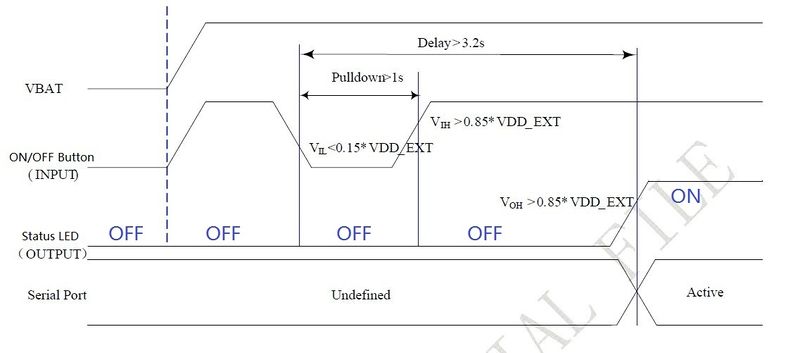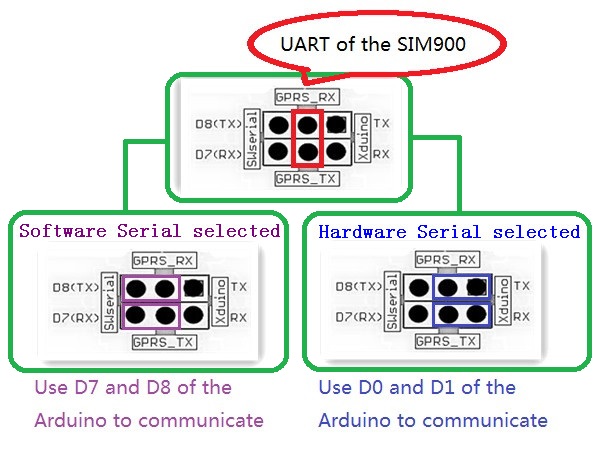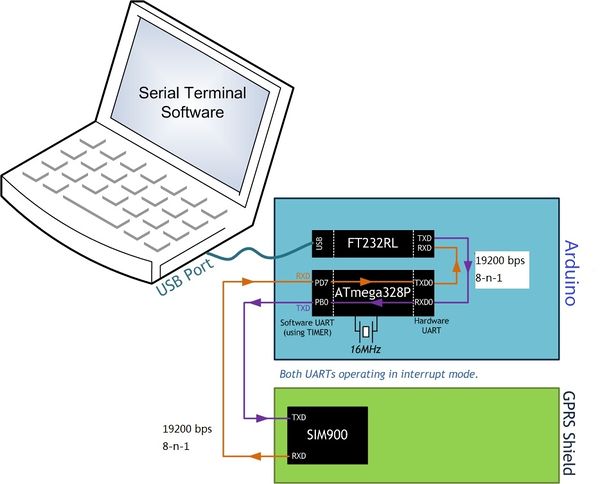Arduino GPRS Shield
Contents
Introduction
The GPRS Shield is based on SIM900 module from SIMCOM and compatible with Arduino and its clones. The GPRS Shield provides you a way to communicate using the GSM cell phone network. The shield allows you to achieve SMS, MMS, GPRS and Audio via UART by sending AT commands (GSM 07.07 ,07.05 and SIMCOM enhanced AT Commands). The shield also has the 12 GPIOs, 2 PWMs and an ADC of the SIM900 module(They are all 2V8 logic) present onboard.
Features
- Quad-Band 850 / 900/ 1800 / 1900 MHz - would work on GSM networks in all countries across the world.
- GPRS multi-slot class 10/8
- GPRS mobile station class B
- Compliant to GSM phase 2/2+
- Class 4 (2 W @ 850 / 900 MHz)
- Class 1 (1 W @ 1800 / 1900MHz)
- Control via AT commands - Standard Commands: GSM 07.07 & 07.05 | Enhanced Commands: SIMCOM AT Commands.
- Short Message Service - so that you can send small amounts of data over the network (ASCII or raw hexadecimal).
- Embedded TCP/UDP stack - allows you to upload data to a web server.
- RTC supported.
- Selectable serial port.
- Speaker and Headphone jacks
- Low power consumption - 1.5mA(sleep mode)
- Industrial Temperature Range - -40°C to +85 °C
Specifications
Application Ideas
- M2M (Machine 2 Machine) Applicatoions.
- Remote control of appliances.
- Remote Weather station or a Wireless Sensor Network.
- Vehicle Tracking System with a GPS module.
Cautions
- Make sure your SIM card is unlocked.
- The product is provided as is without an insulating enclosure. Please observe ESD precautions specially in dry (low humidity) weather.
- The factory default setting for the GPRS Shield UART is 19200 bps 8-N-1. (Can be changed using AT commands).
- NewSoftLibrary library only support baudrate under 38400bps, it may lose data while communicate over 38400bps.
- The standard NewSoftSerial library doesn't have support for receive on the Mega. Bhagman has written a new version of NewSoftSerial that has this support:
http://www.arduino.cc/cgi-bin/yabb2/YaBB.pl?num=1287382108
http://code.google.com/p/rogue-code/downloads/detail?name=NewSoftSerial10c-withMegaAndStream.zip
He've tried this new library. One limitation is that it only works on pins that support interrupts(Pin11,12), so on the Mega it only works on Hardware UART.
- The default Buffer of Rx in NewSoftSerial.h is 32, you may experience some data lose while the returns of SIM900 are many(Receiving SMS/TCPIP), you can try to change the Buffer of Rx in NewSoftSerial.h into
Hardware Diagram
Getting Started
AT Command syntax
AT Command is simple textual commands communicated with GPRS Shield over its serial interface (UART). The "AT" or "at" prefix must be set at the beginning of each Command line. To terminate a Command line enter <CR>. Commands are usually followed by a response that includes. "<CR><LF><response><CR><LF>" Throughout this document, only the responses are presented, <CR><LF> are omitted intentionally.
Note: A HEX string such as "00 49 49 49 49 FF FF FF FF" will be sent out through serial port at the baud rate of 115200 immediately after SIM900 is powered on. The string shall be ignored since it is used for synchronization with PC tool. Only enter AT Command through serial port after SIM900 is powered on and Unsolicited Result Code "RDY" is received from serial port. If auto-bauding is enabled, the Unsolicited Result Codes "RDY" and so on are not indicated when you start up the shield, and the "AT" prefix, not "at" prefix must be set at the beginning of each command line.
For more information please refer to AT Commands Manual v1.03.
Power Up and Power Dowm the GPRS Shield
Power Up the GPRS Shield
The GPRS Shield can be turned on by two ways:
- 1, Hardware Triger; Press the ON/OFF Button about two seconds.The power up scenarios illustrates as following figure:
- 2, Software Triger; If use this way to power up the GPRS Shield, JP need to be soldered, then Digital Pin 9 of the Arduino will act as Software Triger port and Digital Pin 9 can not be use as other purpose. Then give Digital Pin 9 a Turn on Impulse can power up the GPRS Shield. The power up scenarios illustrates as following figure:
The following code is power up subroutine for Arduino if using software triger:
void powerUp()
{
pinMode(9, OUTPUT);
digitalWrite(9,LOW);
delay(1000);
digitalWrite(9,HIGH);
delay(2000);
digitalWrite(9,LOW);
delay(3000);
}
When power on procedure completes, the SIM900 will send out following result code to indicate the GPRS shield is ready to operate; When set as fixed baud rate, the SIM900 will send out result code: RDY This result code does not appear when auto baud rate is active.
- 3, Normal power down procedure:Turn off the GPRS shield by sending AT command “AT+CPOWD=1” to SIM900 module.
When GPRS Shield power dowm in Normal power down procedure, the procedure lets the SIM900 log off from the network and allows the software to enter into a secure state and save data before completely disconnecting the power supply. Before the completion of the power down procedure the SIM900 will send out result code: NORMAL POWER DOWN
- 4, Over-voltage or Under-voltage Automatic Power Down: SIM900 will constantly monitor the voltage applied on the VBAT.
①If the voltage ≤ 3.3V, the following URC will be presented:
UNDER-VOLTAGE WARNNING
②If the voltage ≥ 4.7V, the following URC will be presented:
OVER-VOLTAGE WARNNING
③The uncritical voltage range is 3.2V to 4.8V. If the voltage > 4.8V or < 3.2V, SIM900 will be automatic power down soon. If the voltage < 3.2V, the following URC will be presented:
UNDER-VOLTAGE POWER DOWN
④If the voltage > 4.8V, the following URC will be presented:
OVER-VOLTAGE POWER DOWN
- 5, Over-temperature or Under-temperature Automatic Power Down: SIM900 will constantly monitor the temperature of the module.
①If the temperature > 80℃, the following URC will be presented:
+CMTE:1
②If the temperature < -30℃, the following URC will be presented:
+CMTE:-1
③The uncritical temperature range is -40℃ to +85℃. If the temperature > +85℃ or < -40℃, the module will be automatic power down soon. If the temperature > +85℃, the following URC will be presented:
+CMTE:2
④If the temperature < -40℃, the following URC will be presented:
+CMTE:-2
When the GPRS Shield encounters POWER DOWN scenario, the AT commands can not be executed. The SIM900 logs off from network and enters the POWER DOWN mode, only the RTC is still active. POWER DOWN can also be indicated by STATUS LED(Blue), which is off in this mode.
Note:
- To monitor the temperature, users can use the “AT+CMTE” command to read the temperature when GPRS Shield is powered on.
- To monitor the supply voltage, users can use the “AT+CBC” command which includes a parameter: voltage value(in mV) when GPRS Shield is powered on.
Power Down the GPRS Shield
Serial Port(UART) Communication
The GPRS Shield is used UART protocol to communicate with an Arduino/Arduino clone; Users can use jumpers to connect (RX,TX) of the shield to either Software Serial(D8,D7) or Hardware Serial(D1,D0) of the Arduino.Detailed information is showed as the following picture:
Note:
- Users can use “AT+IPR=?” command to see supported baudrate, it will response a list of supported baudrate.
- Users can use “AT+IPR=x”(x is value of supported baudrate) to set a fixed baud rate and save the configuration to non-volatile flash memory.
- When users select Software Serial to communicate, NewSoftLibrary library should be install in arduino‘s libraries.
- NewSoftLibrary library only support baudrate under 38400bps.
Indicator LEDs
There are three indicator LEDs(PWR(Green), Staus(Blue), Netlight(Red)) on the GPRS Shield, users can know about the working state of the shield based on the three indicator LEDs. Detailed information please refer to the following table:
SIM Card Installation
An unlocked SIM card should be inserted in SIM Card Holder on the bottom side of the shield. Both 1.8 volts and 3.0 volts SIM Cards are supported by SIM900 and the SIM card voltage type is automatically detected by SIM900.
Note: Make sure your SIM Card is unlocked; If you not sure, you can check with your provider.
Antenna Interface
The shield comes with a GSM qurd-band antenna; Make sure the antenna is assembled and antenna pad is buckled properly.
Audio Interface
The GPRS Shield has 3.5mm Microphone interface and Speaker Interface, If you want to make voice calls, you would also require a headset with microphone.
Upload Sketch to Arduino
The following sketch configures Arduino/Arduino clone as serial link between PC and the GPRS Shield(Jumpers on SWserial side). PC would need a serial terminal software to communicate with it - Window's built-in HyperTerminal, Arduino IDE's Serial Monitor, Serial Terminals(sscom32) or Bray++ Terminal.
After uploading the sketch to the Arduino board, press the ON/OFF button on the GPRS Shield to turn it on; Now you can see what you get on the serial terminal and the status of the three indicator LEDs, then communicate with your Shield
//Serial Relay - Arduino will patch a
//serial link between the computer and the GPRS Shield
//at 19200 bps 8-N-1
//Computer is connected to Hardware UART
//GPRS Shield is connected to the Software UART
#include <NewSoftSerial.h>
NewSoftSerial mySerial(7, 8);
void setup()
{
mySerial.begin(19200); // the GPRS baud rate
Serial.begin(19200); // the GPRS baud rate
}
void loop()
{
if(Serial.available())
{
mySerial.print((unsigned char)Serial.read());
}
else if(mySerial.available())
{
Serial.print((unsigned char)mySerial.read());
}
}
Note:
- Make sure you install NewSoftLibrary library properly.
- The "AT" or "at" prefix must be set at the beginning of each Command line. To terminate a Command line enter
Examples
- The default Buffer of Rx in NewSoftSerial.h is 32, you may experience some data lose while the returns of SIM900 are many(Receiving SMS/TCPIP), you can try to change the Buffer of Rx in NewSoftSerial.h into
#define _NewSS_MAX_RX_BUFF 128 // RX buffer size
Sending SMS: using Software UART
#include <NewSoftSerial.h>
NewSoftSerial mySerial(7, 8);
void setup()
{
mySerial.begin(19200); //Default serial port setting for the GPRS modem is 19200bps 8-N-1
mySerial.print("\r");
delay(1000); //Wait for a second while the modem sends an "OK"
mySerial.print("AT+CMGF=1\r"); //Because we want to send the SMS in text mode
delay(1000);
//mySerial.print("AT+CSCA=\"+919032055002\"\r"); //Setting for the SMS Message center number,
//delay(1000); //uncomment only if required and replace with
//the message center number obtained from
//your GSM service provider.
//Note that when specifying a tring of characters
// " is entered as \"
mySerial.print("AT+CMGS=\"+9184460xxxx\"\r"); //Start accepting the text for the message
//to be sent to the number specified.
//Replace this number with the target mobile number.
delay(1000);
mySerial.print("Hi from Geekonfire!\r"); //The text for the message
delay(1000);
mySerial.print(26,BYTE); //Equivalent to sending Ctrl+Z
}
void loop()
{
//We just want to send the SMS only once, so there is nothing in this loop.
//If we put the code for SMS here, it will be sent again and again and cost us a lot.
}




